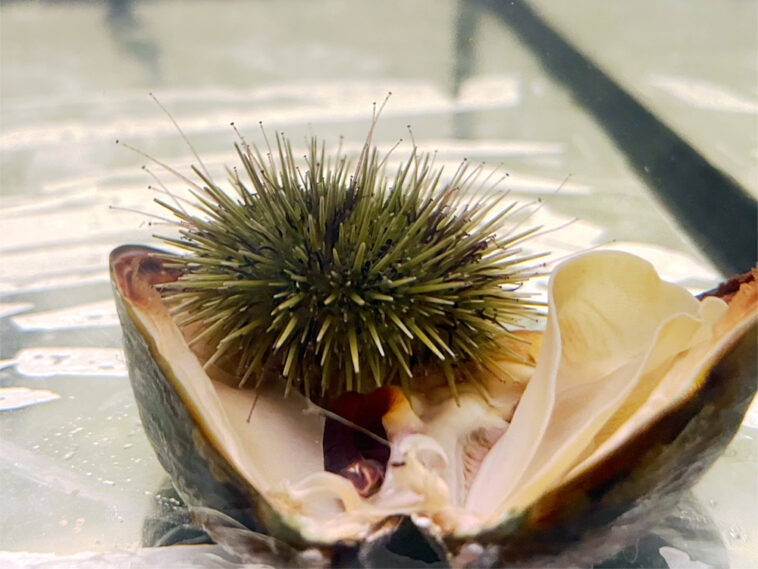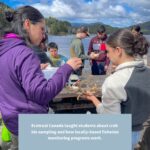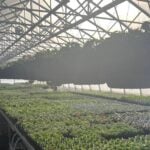Michelle Gamage / Local Journalism Initiative / The Tyee
When it’s feeding time, Vancouver Island University biology student Chloe McLaughlin carefully scoops a palm-sized green sea urchin out of a tank.
Flipping it upside down, she exposes the creature’s mouth and gently feeds it a biotoxin that is highly poisonous to humans.
The biotoxin, also known as paralytic shellfish poison, affects only creatures with central nervous systems, she says. Potentially lethal to humans, it doesn’t hurt sea urchins or other bivalve filter feeders such as oysters, clams, scallops, mussels and cockles.
This experiment is part of a larger collaboration between the Canadian Food Inspection Agency and Vancouver Island University to improve testing for biotoxins in seafood and ultimately improve food security for remote and Indigenous communities along the coast, says lead researcher Timothy Green, VIU’s Canada Research Chair in shellfish health and genomics.

Coastal Indigenous communities are at higher risk of being affected by paralytic shellfish poison because their diets rely more heavily on seafood than those of the general population, Green says. A person in Bella Bella, for example, eats about 24 times more seafood than someone in Kelowna.
Harvesting, eating and sharing traditional foods supports the culture, community and public health of First Nations. And there may not be other healthy or affordable food sources available. A study published this winter also found that reducing how much seafood a First Nations person could eat in B.C. increased their risk of heart disease.
There are ongoing Indigenous-led initiatives working to test and identify hazards in their own waters too, like the We All Take Care of the Harvest project run by the First Nations Health Authority, and biotoxin testing labs set up by Southeast Alaska Tribal Testing program.
McLaughlin is exposing sea urchins to paralytic shellfish poison, or PSP, to see if they bioaccumulate the toxin to dangerous levels. If they don’t, sea urchins can continue to be relied on as a safe, alternative food source for Indigenous communities when shellfish harvesting gets shut down due to biotoxin risk, Green said.
“Could we eventually get a test that’s reliable and easy to use like a pregnancy test or COVID RAT [rapid antigen test] into Indigenous communities which could tell people if the seafood is safe to eat? That’s our aim.”
Timothy Green, VIU’s Canada Research Chair in shellfish health and genomics
The ultimate goal is to create a portable and accessible testing kit that can be widely distributed to remote communities to accurately test for biotoxins that can be lethal when consumed but have no taste or smell and can’t be cooked off, Green said.
These biotoxins can remain in clams for two years after the animals are exposed, he added.
“Could we eventually get a test that’s reliable and easy to use like a pregnancy test or COVID RAT [rapid antigen test] into Indigenous communities which could tell people if the seafood is safe to eat? That’s our aim,” Green said.
These tests would need to check for hundreds of biotoxins, but Green is optimistic. “Bright ideas happen all the time,” he said.
How biotoxin testing currently works
Currently there’s only one lab in Western Canada that tests Pacific shellfish for biotoxins, says Carolyn Bateman, director of the CFIA Burnaby laboratory.
The lab tests for toxins that cause paralytic shellfish poisoning, amnesic shellfish poisoning and diarrhetic shellfish poisoning.
When an area is declared safe, harvest can be allowed — so long as it’s the right season and harvesters have rights or a licence to harvest in an area. The BC Centre For Disease Control and Fisheries and Oceans Canada both have maps that show what areas are open for harvest. The Can U Dig It app is a free, mobile-friendly version of the DFO map.
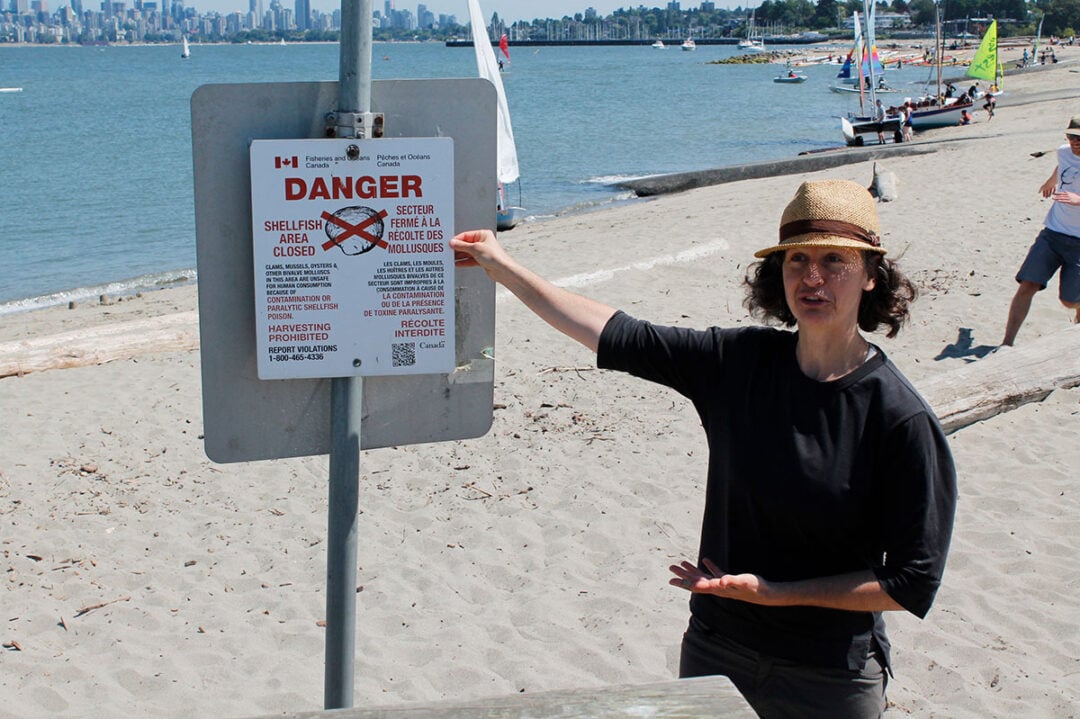
Bateman said the current testing method is “expensive, complex and infrastructure heavy” and requires highly trained chemists to prepare live samples for testing on “very expensive chemistry instruments.”
Adding to the overall cost, it’s beneficial to have a couple of backup machines in case one goes down and takes days to repair, she said.
While the test results are accurate, Bateman says, the testing process is slow, and cost-prohibitive for remote communities. The remoteness of some communities also creates barriers to shipping live samples to the lab, she added.
Testing for PSP means testing for 12 toxins and seeing how each one contributes to overall toxicity in people, Bateman said. In mild cases it can cause numbness in the mouth and limbs, and in severe cases it can cause incoherent speech, respiratory paralysis and death, according to DFO.
PSP is one of the most potent natural poisons in the world and has no known antidote, DFO says.
“[Diarrhetic shellfish poisoning] feels like you’re going to die but you will survive.”
Carolyn Bateman, director of the CFIA Burnaby laboratory
Amnesic shellfish poisoning, also known as domoic acid poisoning, causes severe nausea, vomiting and diarrhea within six hours, and within 48 hours can progress to neurological symptoms like disorientation, memory loss, coma and death, according to the Washington Department of Fish and Wildlife.
Diarrhetic shellfish poisoning “feels like you’re going to die but you will survive,” Bateman said. It causes diarrhea, nausea, vomiting and cramps.
PSP is caused by red tide, which happens when there is a bloom, or explosion in population, of single-celled plants known as phytoplankton that live in the ocean. As bivalves feed on the phytoplankton, the toxin accumulates in their bodies.
The Burnaby CFIA lab tests all shellfish in B.C. If you’ve enjoyed local mussels at a restaurant or bought oysters from a fishmonger, you’ve got Bateman’s team to thank.
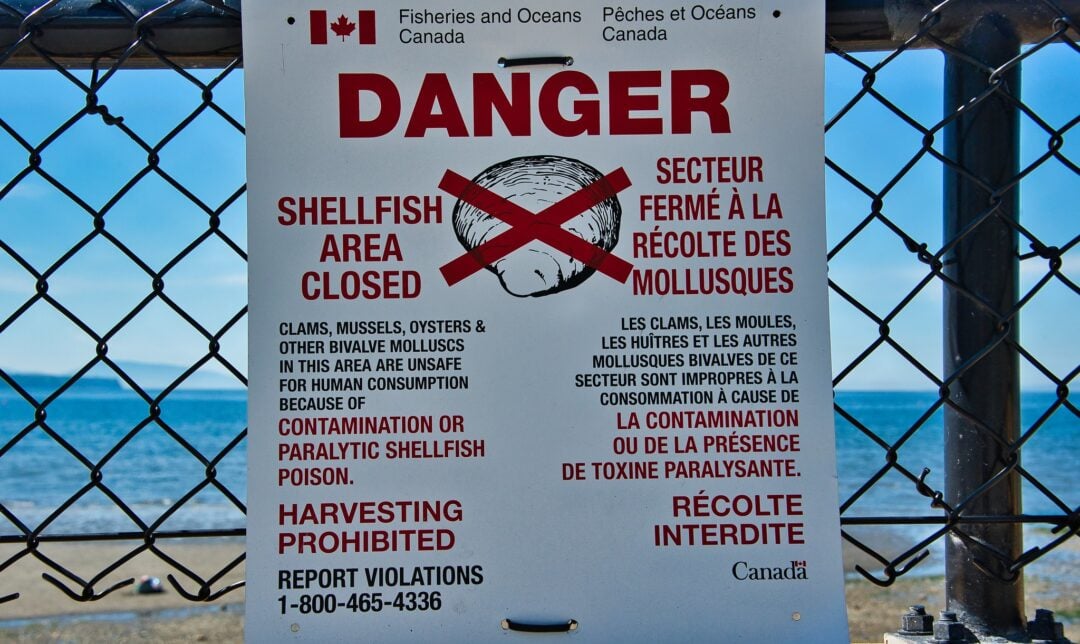
Shellfish testing has largely been built around the commercial harvest, Green said. Shellfish farms tend to be set up along accessible shipping routes, making it easier to ship animals in for regular testing. By comparison, shipping seafood from remote communities takes a week at best, which increases the chances the shellfish arrive dead and can’t be tested.
Warming oceans are supporting more frequent red tide blooms and the season is getting longer, starting during a warm spring and lasting into the fall, Bateman said.
It’s also possible to have a red tide that doesn’t produce any biotoxins or a very minor bloom that produces a lot of toxins, she said.
Different bivalve species take up the toxin differently. Mussels are quick to absorb the biotoxins but also quick to purge them from their system, Bateman said, while butter clams hold on to toxins for quite a long time.
“[Canada is a bit of a] hot spot [for marine biotoxins], and it’s getting worse.”
Timothy Green, VIU’s Canada Research Chair in shellfish health and genomics
If someone is poisoned by PSP and is able to get emergency medical care, it’s possible to be put on a respirator while your body works through the toxin, Bateman added — but remote communities might not have access to these emergency health services.
Anyone who eats shellfish and experiences tingling in their mouth, jaw or hands should call 911 or poison control right away.
Canada is a bit of a “hot spot” for marine biotoxins, Green said, “and it’s getting worse.” Marine heat waves like the Blob are associated with biotoxin blooms.
Without accessible and reliable testing, Green said, remote communities are forced to adopt strategies like having the largest member of the community take a “nibble” to see if they get sick — the safety measure being that their larger body means they can handle more toxins.
It’s not fair to force communities to resort to this in the 2020s, Green said. “Within the decade we hope to have something better to mitigate risks.”
Improving testing
One big bottleneck Green and Bateman both pointed to is how shellfish samples have to be shucked and prepared at the Burnaby lab.
Shucking needs to be done carefully. If a bivalve’s guts are ruptured, it can change the pH of the tissue and create false test results, Bateman said.
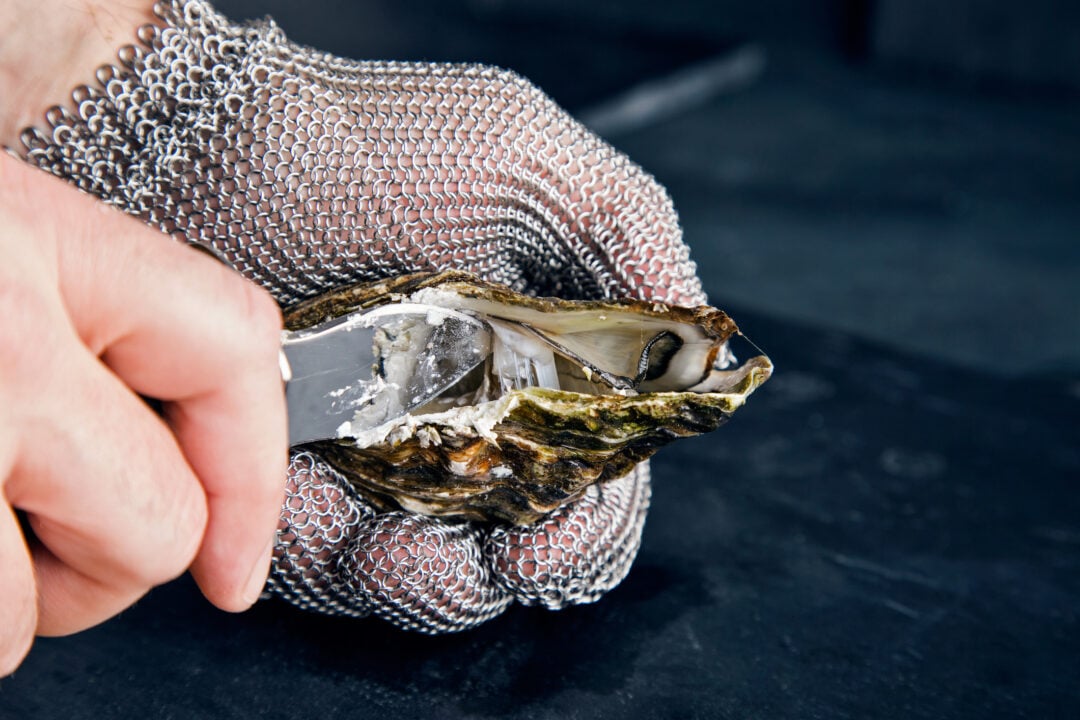
The Canadian Food Inspection Agency is working with Vancouver Island University to create a second lab where shellfish can be processed and then shipped to the Burnaby lab for testing.
Bateman said this second lab will also be used to train new chemistry analysts who can help speed up testing.
Green said another possible solution that is being explored at VIU is using mass spectrometry to test samples dabbed onto paper. Mass spectrometry creates a reading of every single molecule in a sample, allowing researchers to then check for the presence of toxins.
Mass spectrometry is used as the gold standard for drug testing.
Dabbing a sample on paper could mean only the paper needs to be shipped to a lab for testing, Green said.
Turning to uni
McLaughlin is trying to see if green sea urchins absorb PSP into their gonads, also called “uni,” which can be a valuable food source as they are high in protein and omega-3 fatty acids, similar to salmon.
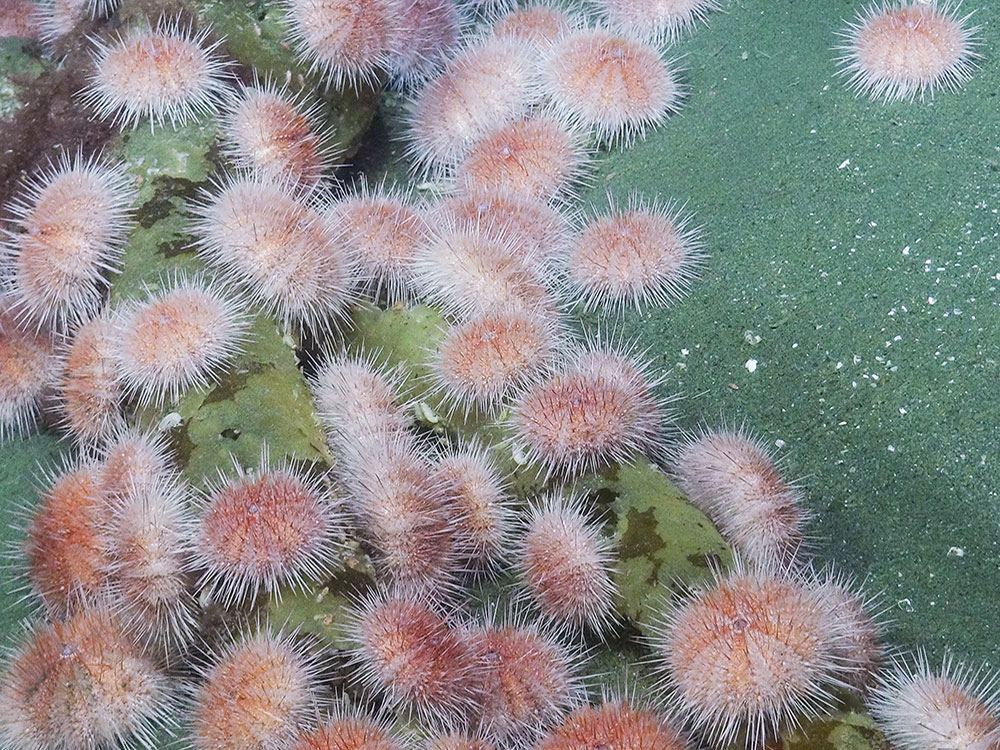
Sea urchins are herbivores, grazing on kelp and other seaweed. Under normal circumstances, they don’t eat food sources that contain biotoxins, so toxins don’t bioaccumulate in their bodies, McLaughlin said.
They can be harvested year-round, according to DFO, with a valid B.C. tidal waters sport-fishing licence. Some Indigenous fishers may have rights to harvest without a licence.
In recent years there’s been a huge die-off in sea urchins’ natural predators, such as sunflower sea stars, which has allowed sea urchin populations to explode. Urchins will eat all the seaweed in an area, creating what is known as an urchin barren, with no food sources left.
McLaughlin said a handful of urchins have been found around the world with biotoxins below the reportable limit of 80 micrograms per 100 grams of tissue — any higher and there could be a risk to humans, she added.
How those urchins bioaccumulated those toxins and whether it’s possible for urchins to contain dangerous toxin levels are some of the many questions McLaughlin is hoping to answer through her research.
“We need to know how to inform people whether it’s safe to harvest.”
Timothy Green, VIU’s Canada Research Chair in shellfish health and genomics
If sea urchins are starving, they will adopt an omnivorous diet and will eat dead things or forage for whatever they can find, such as algae and other animals, McLaughlin said, which could increase their risk of containing paralytic shellfish toxin.
“We need to know how to inform people whether it’s safe to harvest,” Green said.
“If you say ‘Don’t eat clams,’ what is the alternative food source? Is it healthy? Clams are healthy.”


